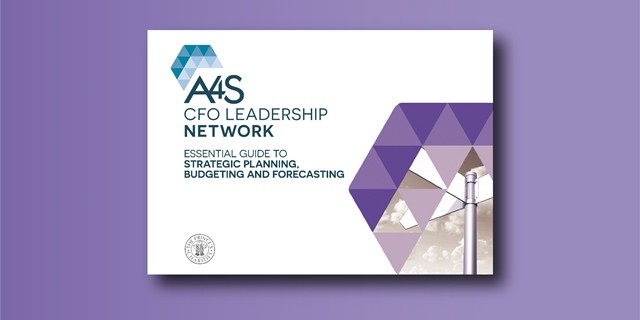Practical approaches for bringing sustainability into financial planning

Reflections on A4S’s Sustainability in Action webinar on strategic planning, budgeting and forecasting
Date: September 2023
Speakers:
Baia Ouldsliman (Financial Analyst at the City of Montréal)
The City of Montréal is aiming to speed up the ecological transition and to strengthen solidarity, equality and inclusion. The city’s strategic plan is supported by specific targets, including greenhouse gas (GHG) emissions reduction targets.
Laura Palmeiro (Head of Sustainable Finance at Danone)
As part of Danone’s Renew strategy, the company has reframed its sustainability approach, around three pillars – health, nature and people & communities – with priorities and objectives linked to each pillar.
Lori Defnet (ESG Finance Manager at The Hershey Company)
Sustainability is core to Hershey’s strategy through its Shared Goodness Promise - Hershey's holistic sustainability strategy that guides how it creates more moments of goodness by delivering on commitments to safeguard the health of the environment, support children and youth and build prosperous communities within its supply chain.
Approaches to strategic planning, budgeting and forecasting
Sustainability strategies and targets must be incorporated into strategic planning, budgeting and forecasting processes to create alignment throughout the organization and turn ambitions into action. Organizations can use a range of techniques for incorporating sustainability into their planning, budgeting and forecasting processes, applying these either individually or in combination. What works for any one organization will depend on their strategic goals and the pace and nature of the change that they are seeking.
The simplest approach is ringfencing. This involves setting aside a specific budget that can be used to fund the costs of meeting strategic sustainability goals. For example, 10–15% of the City of Montréal’s budget is set aside to fund its capital works programme for climate change infrastructure adaptation and natural infrastructure investment. Having a separate budget for this means that the city can more easily plan and track these climate- and nature-focused activities.
Ringfencing can be combined with allocation, which involves making choices about how to distribute a budgeted amount across the organization and over time. Hershey ringfences money for its work towards sustainability targets, and then allocates that total budget across the business based on what will best support its strategic goals and plans. For example, a range of sustainability factors are relevant to the cocoa business line, which can also be a significant driver of emissions, and so this business line gets a higher-than-average allocation from the ringfenced sustainability budget. Hershey then consolidates the business units’ plans to assess them from a whole-organization perspective.
One feature of allocation can be empowering teams. Hershey’s approach has “empowered different business process owners across the business to own aspects of that sustainability budgeting and forecasting process,” said Lori.
Meanwhile, Danone has set overall targets for emissions reduction for each country, with local teams determining how those targets are met. Laura said this has enabled Danone to adapt its emissions reduction approach to the various local contexts in which it operates. “We are giving all autonomy to the local teams to define which is the best strategy for each of them. Realities in the countries are very different from one another.” In developing their budgets, local teams have access to support from the central finance function and Danone’s internal experts on reducing GHG emissions.
Another approach is voluntary internal pricing. An example of this at work is when organizations incorporate a carbon price into decision making. This can be through a shadow price (where a price is applied to carbon to inform decision making but not actually charged) or an internal carbon fee (where an actual fee is paid). Danone uses an internal shadow carbon price in its net present value calculations when appraising capex projects.
Baia from the City of Montréal also discussed the city’s use of a climate budget. The climate budget works alongside the city’s climate plan – which outlines how the city intends to achieve its climate targets – and its financial budget. The climate budget is a way to ensure that the city’s climate targets are considered in decision making across its governance structure. Baia said that it helps the city answer important questions, such as, “Are the current climate measures aligned with organization’s commitments and targets?”
The benefits of incorporating sustainability
Integrating sustainability in these ways helps organizations embed sustainability into their day-to-day activities at all levels. Baia said that these approaches supported the City of Montréal to build its financial resilience, which “is key to continue providing essential services”. This resilience can also be boosted by the sense of ownership that can come from building sustainability into the organization’s planning, budgeting and forecasting processes. Hershey has found that “getting the whole business involved really puts the ownership in everyone’s seat”, said Lori.
Laura noted that Danone had also benefited from how motivational it was for staff to see the organization taking sustainability seriously and embedding it into strategy and planning: “People from all over the company, be it in sales or be it in the industrial department, whenever they have the opportunity to work on a project that embeds sustainability, they are extremely motivated.”
Beyond the organization, Baia added that bringing sustainability into the City of Montréal’s financial budget has also sent “a positive signal to different stakeholders – such as investors, citizens, creditors – that we are ready to walk the talk”.
Collaboration
To make real progress, organizations need to work together both within and outside the organization. To achieve this, for Laura “the key word … is collaboration”, with Baia agreeing that embedding sustainability into strategic and financial planning processes “requires collaboration and inclusion”.
Lori noted that intentionally bringing different areas of the business together for strategic planning conversations has put Hershey in a better position to identify the range of sustainability-related risks and opportunities the business faces. Similarly, Danone collaborates widely internally – including seeking input from teams who are involved in delivery – and draws on a variety of sources of information in budgeting and planning. Cross-functional collaboration was an important feature of integrating sustainability into strategic and financial processes for all three organizations.
The importance of collaboration goes beyond the organization, and each panellist said their organization sought external perspectives and expertise. Hershey engages in regular dialogue with investors, peers and wider stakeholders to get a stronger sense of the organization’s impact. Laura said that working closely with partners, peers and academics helped Danone – and its partners – understand and address shared sustainability challenges in areas such as regenerative agriculture. The City of Montréal also partners with universities, using these connections to strengthen its capacity for gathering and using forward-looking, sustainability-related data.
The role of finance
Given sustainability’s links to financial processes, finance teams have much to offer when it comes to incorporating sustainability into strategic planning, budgeting and forecasting. Lori pointed out that finance brings “structure and governance to the process,” and highlighted the value of finance and sustainability teams working closely together. Each team can benefit from the other’s expertise and provide useful points of challenge.
Through its business partnering function, finance can also support upskilling across the organization, with finance operating as a bridge between the sustainability function and the rest of the organization. Already used to translating technical financial concepts in a way understandable to a general audience, finance can use this skill to engage staff in sustainability planning, budgeting and forecasting. Lori said that finance is able to explain to the organization “what sustainability investments are, what they’re driving and why it matters for Hershey”.
The panellists noted that sourcing sustainability-related data and incorporating it into budgets and strategic plans can present challenges and that finance has an important role to play here. The finance team can apply its experience in working with data to help ensure that decision making is supported by robust, reliable data and thorough analysis.
Laura suggested even imperfect data can provide a useful sense of direction and progress. It is best to simply get started, being transparent about the quality and limitations of data and any subsequent restatements, which is something that accountants are well placed to do.
Where to go next
A4S has a range of resources on strategic planning, budgeting and forecasting to help you get started or enhance your existing processes. The A4S Essential Guide to Strategic Planning, Budgeting and Forecasting contains tools, practical examples and guidance, as well as a maturity map to help you assess what you are already doing and how you can improve. More information about how organizations are using carbon pricing is available in our Storebrand, National Grid and British Land case studies.
To join us for future interactive panel discussions on different aspects of embedding sustainability into financial decision making, check out upcoming webinars in our Sustainability in Action series. And sign up for the A4S mailing list to stay up to date with all our latest blogs, publications and events.



